An ergonomic keyboard tray is a fundamental component of a well-designed workspace, engineered to promote proper posture and reduce musculoskeletal strain during computer use. By allowing users to position their keyboard and mouse at an optimal height and angle relative to their body and chair, these trays can significantly mitigate the risk of repetitive strain injuries (RSIs) such as carpal tunnel syndrome and tendonitis. This guide provides a comprehensive, purely informational overview of keyboard trays, their benefits, and a detailed look at several models available.
Understanding the Core Benefits of an Ergonomic Keyboard Tray
Prolonged typing with wrists extended upwards, downwards, or bent to the side can lead to significant discomfort and long-term health issues. An adjustable keyboard tray addresses these issues directly.
- Neutral Wrist Posture: The primary benefit is achieving a neutral or negatively tilted wrist posture. This means the hands are either level with or slightly lower than the forearms, minimizing pressure on the median nerve within the carpal tunnel.
- Improved Shoulder and Neck Alignment: By lowering the keyboard, users can keep their shoulders relaxed and down, rather than hunched forward. This reduces strain on the neck and upper back.
- Increased Desk Space: Mounting the keyboard and mouse beneath the primary desk surface frees up valuable real estate, allowing for a more organized and less cluttered work area.
- Accommodates Different Body Types: A quality tray offers a range of adjustments to suit users of varying heights and builds, which is something a static desk surface cannot provide. For those building a complete workstation, this level of adjustability is as crucial as finding the best monitor for video editing or a comfortable chair.
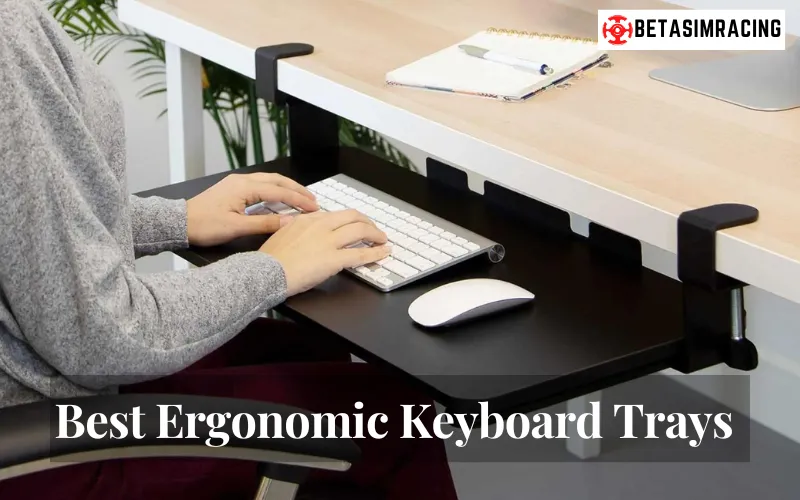
Comparison of Leading Ergonomic Keyboard Trays
This table offers a glanceable overview of the key specifications for the models detailed in this guide.
| Feature | KT1 Under-Desk | EUREKA ERGONOMIC | 3M AKT80LE | StarTech Under-Desk | Mount-It! Clamp-On | EHO Clamp-On | Kantek Clamp-On | Humanscale 6G 500 |
| Mounting Type | Track-Mount | Clamp-On | Track-Mount | Track-Mount | Clamp-On | Clamp-On | Clamp-On | Track-Mount |
| Platform Material | Bakelite | Carbon Fiber Finished Particle Board | Wood | Molded Plastic | MDF | ABS Plastic | Plastic | Phenolic Resin |
| Platform Size (W x D) | 25″ x 9.5″ | 25″ x 9.8″ | 19.5″ x 10.5″ | 25.6″ x 10.2″ | 27″ x 11″ | 20″ x 11.8″ | 20″ x 11.5″ | 27″ x 11″ |
| Height Adj. Range | 4.5″ Below Desk | 5.5″ Below Desk | +1.25″ / -4.5″ | 4.9″ Range | 5.9″ Below Desk | Fixed Height | Fixed Height | 7″ Range |
| Tilt Adj. Range | +10° / -15° | +15° / -15° | +15° / -15° | +15° / -15° | +10° / -21° | Fixed Tilt | +15° / -15° (3 settings) | 0° / -15° |
| Swivel | 360° | 360° | 360° | 360° | 180° | 360° | No | 360° |
| Mouse Platform | Adjustable | Integrated | Adjustable | Integrated | Integrated | Integrated | Integrated | Adjustable |
| Weight Capacity | Not Specified | ~22 lbs | Not Specified | 4.4 lbs (2 kg) | 11 lbs | ~4.4 lbs | Not Specified | Not Specified |
| Wrist Rest | Included | Included (Padded Lip) | Included (Gel) | Included | Included | Included | Included | Included (Gel) |
| Installation | Requires Drilling | Tool-Free Clamps | Requires Drilling | Requires Drilling | Tool-Free Clamps | Tool-Free Clamps | Tool-Free Clamps | Requires Drilling |
Key Considerations When Selecting a Keyboard Tray
Choosing the right tray requires an understanding of its core components and how they relate to individual needs and desk setups.
Types of Keyboard Trays: Track-Mount vs. Clamp-On
- Track-Mount Systems: These are installed by screwing a metal track to the underside of the desk. The keyboard tray arm then slides along this track. This design offers exceptional stability and a wider range of motion, including the ability to slide completely under the desk. It is the more permanent and often more adjustable solution, but it requires drilling into the desk surface.
- Clamp-On Systems: These trays use C-clamps to attach directly to the edge of the desk without any need for tools or drilling. They are ideal for users who cannot or do not wish to modify their desk, such as those with glass-top desks or who are renting. While convenient, they may offer less stability and adjustability compared to track-mounted systems.
Adjustability: The Foundation of Keyboard Tray Ergonomics
The primary value of a keyboard tray lies in its ability to be positioned perfectly for the user.
Height Adjustment
This allows you to position the tray so that your elbows are at a roughly 90-degree angle and your wrists are straight. The range of adjustment, typically measured in inches below the desk surface, is a critical specification.
Tilt Adjustment (Negative and Positive)
The ability to tilt the keyboard is crucial for achieving a neutral wrist posture.
- Negative Tilt: The back of the keyboard is lower than the front. A range of 0° to -15° is standard and highly recommended by ergonomists to prevent wrist extension.
- Positive Tilt: The back of the keyboard is higher than the front. This should generally be avoided as it promotes an unnatural and stressful wrist posture.
Swivel and Rotation
A 360-degree swivel allows the entire tray to be rotated left or right, which is useful for moving it out of the way or for finding a more comfortable angle in corner desk setups.
Platform Size and Material
The tray’s platform must be large enough to accommodate both your keyboard and mouse comfortably. Users with full-size keyboards, number pads, or who require large mouse areas (common in gaming) should look for wider platforms (25 inches or more). The materials range from ABS plastic and particle board to more durable steel and phenolic resin, which affects stability and longevity. An organized setup on the tray is just as important as on your main machine, where knowing which function a motherboard’s chipset performs can help in understanding your computer’s layout.
Installation and Desk Compatibility
For track-mount trays, ensure your desk is thick enough (typically at least 0.75 inches) and made of a material that can hold screws securely (solid wood or MDF is better than particleboard). For clamp-on models, check the maximum desk thickness the clamps can accommodate.
An In-Depth Look at 8 Ergonomic Keyboard Tray Models
1. KT1 Ergonomic Under-Desk Computer Keyboard Tray
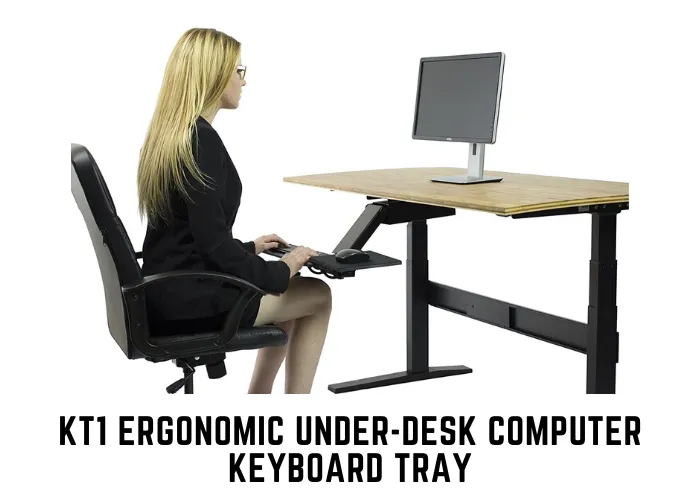
KT1 Key Specifications
- Mounting Type: Track-Mount
- Platform Material: Bakelite
- Platform Size (W x D): 25″ x 9.5″
- Height Adjustment: 4.5 inches below desk
- Tilt Adjustment: +10° / -15°
- Swivel: 360°
Analysis
The KT1 is a track-mounted system that provides a comprehensive range of adjustments. Its key feature is a single-lever mechanism that controls tilt, allowing for straightforward changes to the typing angle. The 360-degree swivel and ability to slide along its track offer significant flexibility in positioning. The platform is wide enough for most standard keyboards and includes an independently adjustable mouse pad area, making it adaptable for both left and right-handed users. The installation requires drilling, making it a permanent addition to a workstation.
2. EUREKA ERGONOMIC Height Adjustable Mouse & Keyboard Tray
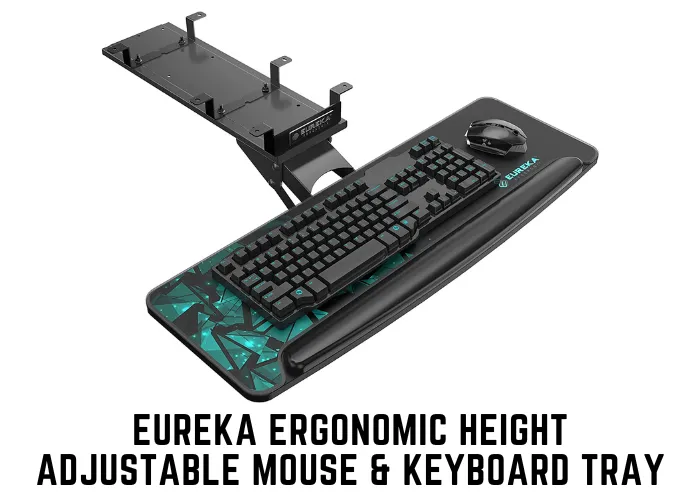
EUREKA ERGONOMIC Key Specifications
- Mounting Type: Clamp-On
- Platform Material: Carbon Fiber Finished Particle Board
- Platform Size (W x D): 25″ x 9.8″
- Height Adjustment: 5.5 inches below desk
- Tilt Adjustment: +15° / -15°
- Swivel: 360°
Analysis
This model from EUREKA ERGONOMIC is a clamp-on tray, offering a drill-free installation process. It features a wide range of motion, including height, tilt, and a full 360-degree swivel. The carbon fiber texture on the surface is geared towards a modern or gaming aesthetic. A notable design element is the padded lip at the front edge which functions as a wrist rest and prevents the keyboard from sliding off when tilted negatively. Its clamp design makes it versatile for desks where drilling is not an option. Such a setup can complement a gaming station, where one might also consider the best racing wheel stand for an immersive experience.
3. 3M Keyboard Tray (Model AKT80LE)
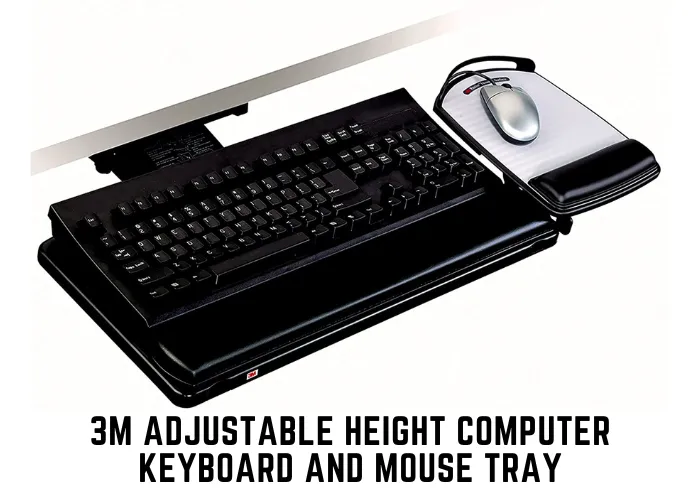
3M AKT80LE Key Specifications
- Mounting Type: Track-Mount (17.75″ track)
- Platform Material: Wood
- Platform Size (W x D): 19.5″ x 10.5″
- Height Adjustment: +1.25″ above to -4.5″ below desk
- Tilt Adjustment: +15° / -15°
- Swivel: 360°
Analysis
The 3M AKT80LE is a robust, track-mounted system known for its extensive adjustability. A key differentiator is its knob-based adjustment for both height and tilt, which allows for precise positioning. The system includes a gel wrist rest for added comfort and a separate, highly adjustable mouse platform that can be tilted and positioned independently of the main keyboard tray. Its durable construction and comprehensive adjustment features make it suitable for intensive, all-day use in professional office environments.
4. StarTech Under-Desk Mount Keyboard Shelf

StarTech Key Specifications
- Mounting Type: Track-Mount
- Platform Material: Molded Plastic
- Platform Size (W x D): 25.6″ x 10.2″
- Height Adjustment: 4.9″ range
- Tilt Adjustment: +15° / -15°
- Swivel: 360°
Analysis
This tray from StarTech is a track-mounted solution designed for stability and a wide range of motion. It provides ample space for both a keyboard and mouse on its single platform. The listed weight capacity of 4.4 lbs (2 kg) indicates it is designed for standard office peripherals. The full swivel and tilt range allow users to achieve an ergonomic position, and the integrated wrist rest provides support. As with other track systems, it requires permanent installation via drilling, which is a consideration for any desk setup, much like deciding how many PCIe slots do I need for a PC build.
5. Mount-It! Clamp-On Ergonomic Keyboard and Mouse Tray
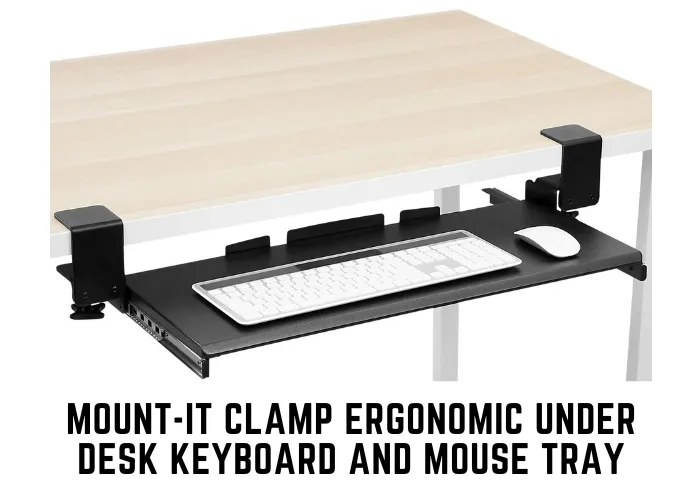
Mount-It! Key Specifications
- Mounting Type: Clamp-On
- Platform Material: MDF (Medium-Density Fiberboard)
- Platform Size (W x D): 27″ x 11″
- Height Adjustment: 5.9 inches below desk
- Tilt Adjustment: +10° / -21°
- Swivel: 180°
Analysis
The Mount-It! clamp-on tray stands out with its extra-wide 27-inch platform, making it an excellent option for users with larger keyboards, including those often used in sim racing games, or those who need extensive mousing space. Its tool-free clamp installation is a major convenience. The tray offers a significant negative tilt range of -21 degrees, which is more than many competitors, allowing for a very neutral wrist posture. The swivel is limited to 180 degrees, which is sufficient for most but less than the full rotation offered by others.
6. EHO Clamp-On Retractable Adjustable Keyboard Tray

EHO Key Specifications
- Mounting Type: Clamp-On
- Platform Material: ABS Plastic
- Platform Size (W x D): 20″ x 11.8″
- Height Adjustment: Fixed Height (relative to desk edge)
- Tilt Adjustment: Fixed Tilt
- Swivel: 360°
Analysis
Note: This product appears to have limited availability or may be discontinued by some retailers. A comparable modern alternative is the VIVO Clamp-on Keyboard Tray (MOUNT-KB05E), which offers similar tool-free installation and a compact design.
The EHO tray is a basic, compact clamp-on solution. Its primary feature is its simplicity and retractable design, allowing it to slide under the desk when not in use. However, it lacks height and tilt adjustability, which are critical for true ergonomic positioning. It serves more as an under-desk shelf to free up desk space rather than a fully ergonomic tool. This model would be suitable only for users who need to clear desk space and find the fixed height and tilt to be coincidentally appropriate for their needs.
7. Kantek Clamp-On Under-Desk Ergonomic Keyboard Tray
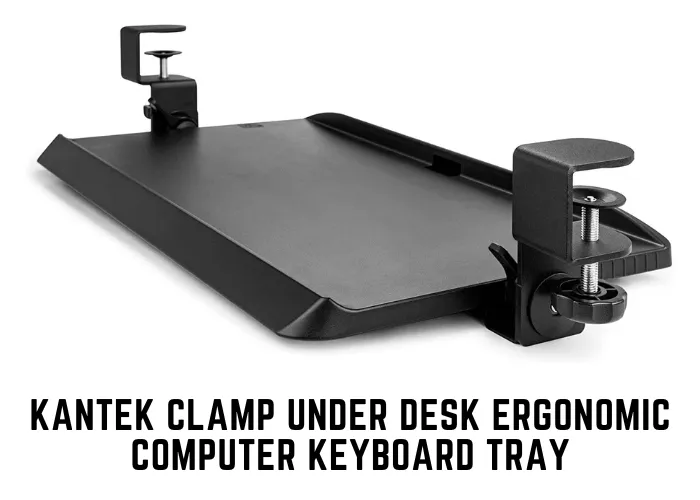
Kantek Key Specifications
- Mounting Type: Clamp-On
- Platform Material: Plastic
- Platform Size (W x D): 20″ x 11.5″
- Height Adjustment: Fixed Height
- Tilt Adjustment: 3 settings (e.g., +15°, 0°, -15°)
- Swivel: No
Analysis
The Kantek clamp-on tray is another entry-level option focused on easy, tool-free installation. Its main drawback is the lack of height adjustment and swivel capabilities. It does offer three distinct tilt settings, which provides some level of ergonomic control, a feature not present in the most basic models. At 20 inches wide, it is best suited for compact or tenkeyless (TKL) keyboards. This is a functional choice for users with limited space and basic ergonomic requirements who cannot drill into their desks.
8. Humanscale 6G 500 Big Platform Ergonomic Keyboard Tray
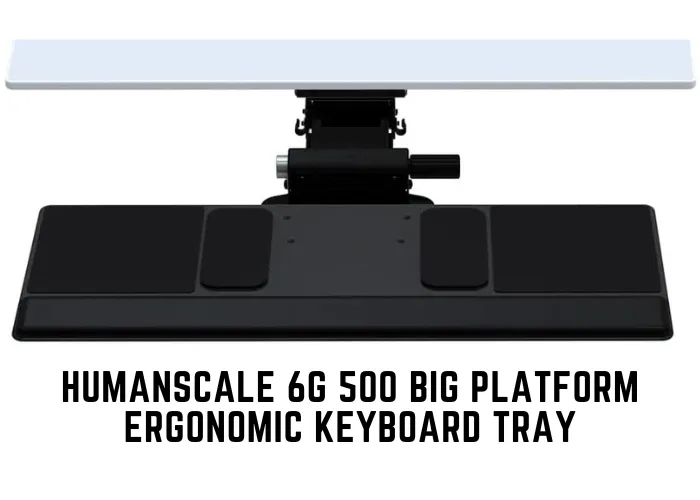
Humanscale 6G 500 Key Specifications
- Mounting Type: Track-Mount
- Platform Material: Phenolic Resin (highly durable)
- Platform Size (W x D): 27″ x 11″
- Height Adjustment: 7″ range
- Tilt Adjustment: 0° to -15° (negative tilt only)
- Swivel: 360°
Analysis
Humanscale is a premium brand in the ergonomics space, and the 6G 500 system reflects this. It is engineered for optimal ergonomic performance, focusing exclusively on neutral and negative tilt (0° to -15°), which prevents users from setting an unhealthy positive tilt. The dial-a-tilt indicator makes it easy to set and remember a precise angle. The platform is constructed from highly durable phenolic resin and is wide enough for extensive setups. It often comes with a separate, independently adjustable mouse platform and high-quality gel palm rests. This system is a high-end investment for users prioritizing maximum durability and precise, health-conscious adjustability.
Frequently Asked Questions (FAQ)
What is the primary purpose of an ergonomic keyboard tray?
The primary purpose is to allow a user to position their keyboard and mouse at a height and angle that promotes a neutral posture. This helps to reduce strain on the wrists, arms, shoulders, and neck, thereby minimizing the risk of developing musculoskeletal disorders.
How do I set up my keyboard tray for optimal ergonomics?
Position the tray’s height so your elbows are bent at approximately a 90-degree angle with your shoulders relaxed. Adjust the tilt so your wrists are straight, not bent up or down; a slight negative tilt of -5° to -10° is often ideal. Your forearms and hands should form a straight line.
Can a keyboard tray cause damage to a desk?
A clamp-on keyboard tray is unlikely to cause damage, though it may leave marks on the finish over time. A track-mounted tray requires drilling holes into the underside of the desk, which is a permanent modification. It is crucial to ensure the desk material is strong enough to support the tray and the pressure of typing.
What is negative tilt and why is it important?
Negative tilt is when the back of the keyboard (closer to the monitor) is angled downwards, lower than the front of the keyboard (closer to you). This is important because it helps prevent wrist extension—the upward bending of the wrist—which is a primary contributor to carpal tunnel pressure and other repetitive strain injuries.
Are larger, full-size keyboards problematic for ergonomics?
A full-size keyboard is not inherently bad, but its width can force the mouse to be positioned further to the side. This can lead to over-extension of the arm and shoulder strain. For users who do not heavily use the number pad, a tenkeyless (TKL) or compact keyboard can allow for a more ergonomic mouse position.
How much under-desk space is required for a track-mounted keyboard tray?
This depends on the length of the track provided with the tray. A common track length is around 17 to 22 inches. You need at least that much flat, unobstructed space under your desk, measured from the front edge backward, to install the track properly. Always check the product specifications for its exact track length.

With 15 years of experience as a PC hardware technician, Ben brings a practical, hands-on approach to our PC Components section. He specializes in real-world testing and longevity analysis, explaining how components perform over time. His guides help readers understand the practical side of owning and maintaining a gaming PC.
